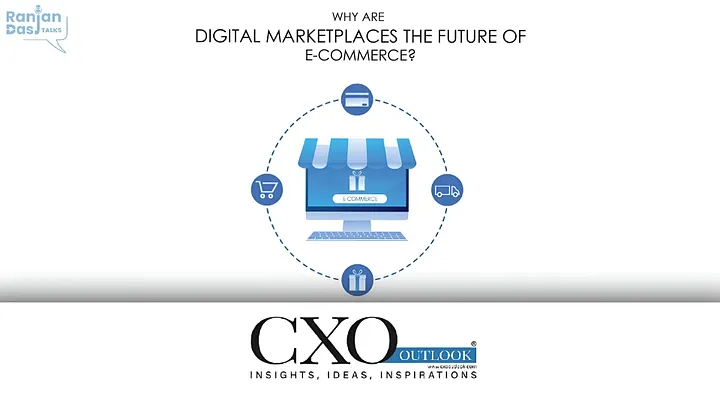
Blog
Why are Digital Marketplaces the Future of E-commerce?
As the digital era continues to take over our lives, its opening up new opportunities and paving new ways for the Future of E-commerce.

Ranjan Das
· Posted: 2021-08-21
Posted: 2021-08-21

Digital Marketplace, since its inception in the early 1980s (with The Boston Computer Exchange), has evolved multi-fold over these four marvelous decades of human desire, demand, marketing, innovation and matchless technological developments. While only two top generalist Digital Marketplaces like Amazon and Ebay can give it an unimaginable volume, shape and reach of 6.9 billion visits/month across the world, other top specialist MarketPlaces like Etsy, Wayfair, Zalando, ASOS and Mano Mano, can convert ~ 840 Million Visits/month with variety of producst from Fashion, Arts & Craft, Gifts to home and furnishing etc. Imagine how big would be the scale and revenue of all big and small digital marketplace, put together.
In 2020, as much as 47% of ecommerce revenue amounting to almost $2 Trillion was registered through digital marketplace. According to new studies, strengthening its growth year over year and now further boosted by COVID, Global eCommerce retail revenue is to hit $4.9 trillion by 2021, dramatically surpassing the Italian consultancy Finaria’s prediction of $3.4 trillion revenue for global ecommerce retail, in 2025. This revenue of $4.9 Trillion is only 17.5% of the total global retail revenue, still leaving a huge scope of what the global retail ecommerce can capture. The percentage of revenue through Digital Marketplace is increasing rapidly, year after year and statistics show the number of people purchasing in web shops is set to reach 4.9 bn by 2025.
Though retail markets are not going anywhere soon as it is already transforming itself to keep pace with the changing time and consumer, digital marketplaces are set to eat into Retail Markets volume, rapidly. Other than converting crisis into an opportunity, registering unprecedented growth during COVID, Digital Marketplaces are ingrained with various other advantages and superiority that makes them ambiguously synonymous with e-commerce.
Digital Marketsplaces can learn, process, retain, leverage and personalise from data collected and analysed to serve the customer better. Now, with the help of machine learning, AI, AR & VR, your cart knows what you want, when you want, what’s your budget, which are your brands of preference, what are the alternatives and even what time slot to get it home delivered at. This knowledge and personalisation are a double whammy, while you get what you want at much better cost without wasting time and energy, brands know your preference well too. Right from offering you what you may like, brands even go to produce and introduce product variants to match what you want, if it forms part of a sizable market. This win-win equation is one of the biggest strengths of a Digital Marketplace, which will have customers coming back to it time and again, buying more and more.
Headless Technology, Voice commerce and proficient image search is helping add more and more new and larger customer sets across various literacy levels and demographics. While the front end of these apps and web stores serve rich content; engrossing, engaging and expanding on the needs and desires of the existing and new found customer base, the backend flawlessly interprets every move of the consumer on this rich front-end to analyse, comprehend, populate and present better and intuitive buying options and features. All of this is facilitated over a more simplified and beneficial buying process, trying to convert every exposure of consumers to these digital marketplaces, into a sale. BuyingEngine and Samsung Shopping’s Shoot & Shop, Say & Shop, Scan & Shop and WhatsApp & Shop are various new methods to input customer’s commands, enabling literate and less literate people from all languages and demographics to benefit from Digital Marketplaces. New entrants like Fruugo, Bonanza, Zalando, BuyingEngine and other digital marketplaces are more experimental and their new initiative and features when proven successful become easy-to-adapt features for the big and established players.
New Digital Payment features and processes are not only reducing Cart abandonment but are also offering consumer add-on benefits for shopping from these Digital Stores. Other than credit and debit cards, digital wallets are also making the inroads with personalisation, Interest Free EMIs, Buy Now Pay Later, huge discounts, Cashback and Loyalty Points. This not only lures the buyer to complete his/her purchase but also make him/her buy more than what they may really need. These offers are specific to certain digital markets and sometimes exclusive too, aimed at increased volume of sale and traffic to these Digital MarketPlaces.
The Global Market is within reach now and that too without travel. 57% of digital shoppers are found to have done purchases once or more at the international Digital Marketplaces, looking to buy what is not available locally or buy something that works as a differentiator between them and the rest of their family and friends. This has initiated cross border shopping and interestingly, one can see an increase in ordering from Asian countries. This all has been possible due to improvement of technology and infrastructure from the non-western regions in the recent past. Expansion or tie ups of American and Western Digital Marketplaces with local digital marketplaces in Asian and African continent has led to grabbing more and more percentage of revenue in the entire ecommerce pie.
Mobile Commerce fused with social selling is going to capture a huge market share of ecommerce transactions. The ease of access, time spent by all age groups across all demographics on their mobile phones and offers made irresistible by price, discount, cashback etc. are resulting in increasing market share of Digital Marketplaces. Various popular socialmedia apps like Tik Tok, Instagram, Twitter, Pinterest, Facebook, and YouTube have been among the first ones to roll out the “buy” button, making significant contribution in the over all sales by Digital Marketplaces
One-in-all is what everyone is turning into. Paytm, Amazon, and Flipkart, all can be seen as a one stop destination for buying all you may ever want to buy or to pay utility bills or get other specialist services by experts. These Digital Marketplaces are leaving no scope for the consumer to go anywhere else.
Overall, these Digital Marketplaces are huge monetising opportunity and platform of interaction between brands and consumers and are being leveraged to unseen levels. These can be as transparent, interactive and mutually beneficial as much as the brands and consumers want it to become. Leveraging this strength, BuyingEngine is working on to introduce ‘Buy Anything Free’ for its premium members, a never before feature that probably may add a new dimension on how Digital Marketplaces can not only become the future of ecommerce but also maybe the Ecommerce itself.
Article is authored by Ranjan Das, MD Apppl Combine
Source: https://www.cxooutlook.com/why-are-digital-marketplaces-the-future-of-e-commerce/
Marketing is everything, products are
woven around it.